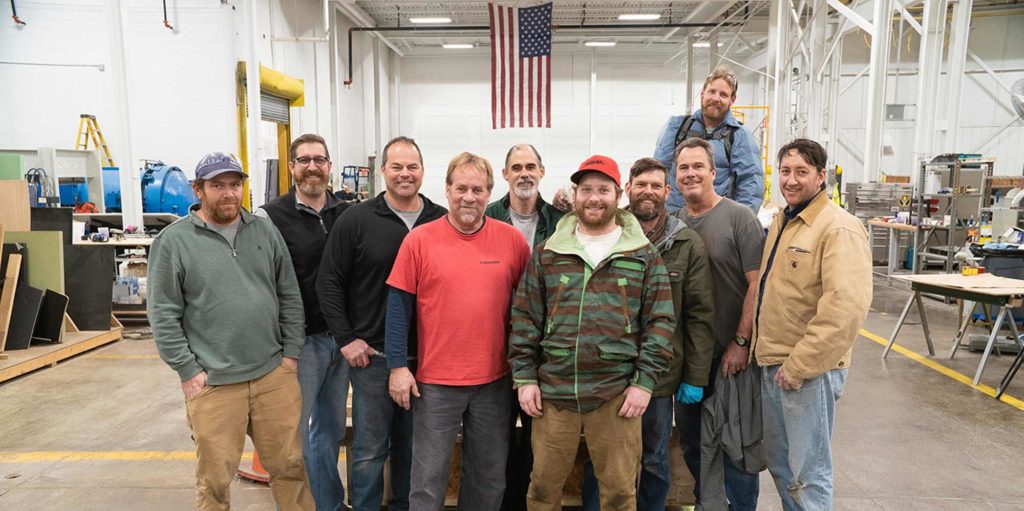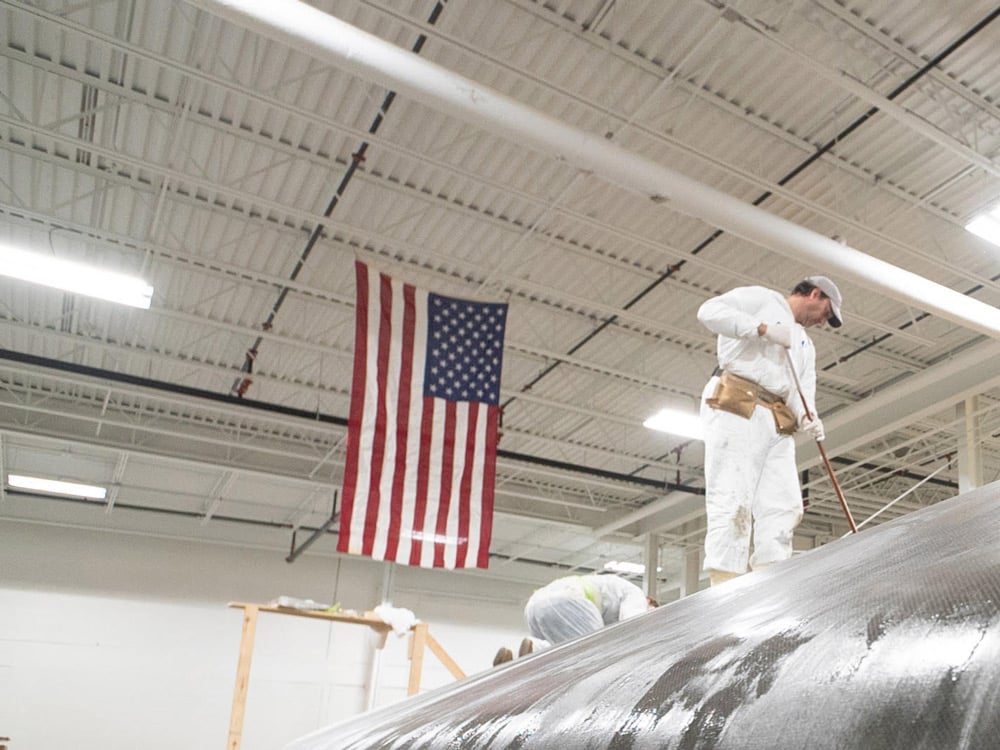
At some point in the summer of 2019, Composite Builders will open the big doors on the backside of its beige 30,000 square-foot fabrication lair and roll out its AC75 for Stars & Stripes Team USA. When this happens, you can bet the town of Holland, Michigan, will know all about it. While the everyday citizen may not realize it today, they’ll soon learn their little city on the shores of Lake Macatawa, once a hub of classic boatbuilding, has given birth to one of the most sophisticated sailboats the world has ever seen.
A dead giveaway of something America’s Cup is afoot in Western Michigan these days is the presence of a few new faces around the neighborhood. They’re here to build a boat — a wicked black one at that — under the leadership of transplanted Nova Scotian Brian MacInnes, a big-armed veteran of numerous Oracle Racing Team campaigns. He’s gone from grinding to working on America’s Cup boats: from IACCs to the Dogzilla trimaran and the Comeback AC72 of San Francisco.
RELATED: Second U.S. America’s Cup Challenger Goes Live
MacInnes (above, third from left) started the composites fabrication company after retiring from professional sailing in 2013. His wife Danielle, whom he met at a regatta in the late 1980s in Antigua, manages the books and keeps the place running smoothly. His son, Rock, runs the clean room and oversees Composite’s other day-to-day production items; like parts for Harken and the Paralympic medal-winning sit skis. MacInnes’s right-hand man, Jon Holstrom, lead boatbuilder for Oracle Racing Team for four campaigns, is essentially quality control and guarantee.
Business has been good since startup, says MacInnes. He’s had to move three times already, with his footprint growing exponentially each time. He only turned on the lights in his new facility in October 2018, just in time to gear up for the production of a foiling 75-footer for Stars & Stripes. His headcount is on the rise, currently at 30 or so, and more hands are on the way.
The Help Wanted sign is out. “Early on, we reached out to a few folks we knew,” MacInnes says, “but there are a lot of good guys out here [in Holland] too.”
They’re drawing builders from coast to coast, from technical schools and connections, and are eagerly looking for young skilled, technical laborers to back the core team. “We’re bringing them in, housing them, feeding them, and building a boat,” MacInnes says. “As this continues and ramps up, we will bring in the hydraulic guys, the electricians, and all the specialists that you need to run a campaign.” By summertime, he says, there will be 40 guys or so trying to find space on the boat to do their work.
“We’re really trying to tap into the younger generation to get them onto the scene,” MacInnes says. “We need to get the younger minds and backs on the team and train them up. I’m 50 years old now and I want to pass along what I know. It’s an awesome opportunity for us to mentor a new group of people.”

Granted, the unproven AC75 is a big step for Composite Builders. Taking on a build of this scale, MacInnes admits, isn’t daunting at all. “I know the guys are super excited. We’ve got a big place and the shop is full and buzzing. Hopefully it will show what West Michigan has to offer. The buzz is getting around and folks are showing up looking for work, so it’s good.”
By springtime, he says, there will be 10 or 15 additional guys buying coffee and egg sandwiches down at the bakery nearby.
Advising on the build, remotely, is Tim Smyth, a guru among New Zealand’s high-tech boatbuilding experts. Smyth’s company, Core Builders, once based in Anacortes, Washington, has had far and deep reaches into virtually every America’s Cup team of recent times, primarily with Oracle Racing. With Stars & Stripes Team USA having purchased a comprehensive design package from Emirates Team New Zealand, Smyth will consult when necessary with Alon Finkelstein, the team’s in-house senior engineer, who will liaise with the Cup defender’s design and engineering teams. Smyth’s role, says Stars & Stripes COO, Todd Reynolds, is to ensure boat No. 1 (of potentially two), is fast, safe, and reliable.
“It’s awesome to consult with Tim,” MacInnes says. “The team was lucky to be able to retain his services for this build. He has an experienced set of eyes and knowledge. The fact that he’s built every Oracle boat that’s come out of the shed since that campaign started…he just knows the ins and the outs of it all, from the ground up. A big part of this build is making sure we have the right information when we need it.”
With an experienced team coming into shape, activity is stirring inside Composite’s facility. Today, there’s a sense of urgency, but key decisions don’t need to be forced, just yet. “With a boat like this, it’s the small parts that bite you,” MacInnes says. “The internals and the framework that’s down below — the nuts and bolts of it. A lot of people like to see the shiny new hull, but really, it’s all the internals we need to get going. We want all the bits and pieces done so we can assemble it once we get our hull.”
Reported delays of supplied one-design components from New Zealand haven’t affected the team’s build progress to date (one benefit of starting late). “For us, it’s not a big concern because, being stock standard items, we can build around those pieces and then fit them in the end,” MacInnes says.
But the clock is running, and so too, are the shifts at Composite. MacInnes had his guys on the floor through Christmas and New Year’s Day as the boat’s major components took shape. He knows his timeline is dictated by the first AC75 regatta planned for Italy in October, and the boat would ideally need to be sea-trialed on Lake Michigan before it ships.
To date, the build has gone “swimmingly well,” MacInnes says. “It was a later start, for sure, but once we got rolling, the information has been flowing very well. Every time we build a boat like this you’re hunting for kilograms, and getting Team New Zealand’s design package behind us is a huge help with their engineering staff. We have the information we need to do it right, and we have a few tricks up our sleeve as well. We don’t have to do it exactly the way they’ve done it.”
When the team does eventually haul the big hull out of Holland on a flatbed, bound for the West Coast or the Mediterranean, whichever comes first, the police escort will either be under the cover of darkness or leading a parade through Holland with a marching band and all. When it’s gone, MacInnes can sweep the space it once occupied and start ramping up the next.









